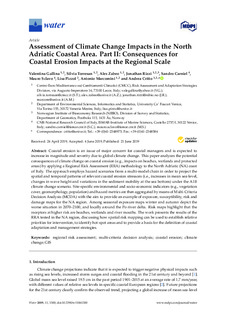Assessment of Climate Change Impacts in the North Adriatic Coastal Area. Part II: Consequences for Coastal Erosion Impacts at the Regional Scale
| dc.contributor.author | Gallina, Valentina | |
| dc.contributor.author | Torresan, Silvia | |
| dc.contributor.author | Zabeo, Alex | |
| dc.contributor.author | Rizzi, Jonathan | |
| dc.contributor.author | Carniel, Sandro | |
| dc.contributor.author | Sclavo, Mauro | |
| dc.contributor.author | Pizzol, Lisa | |
| dc.contributor.author | Marcomini, Antonio | |
| dc.contributor.author | Critto, Andrea | |
| dc.date.accessioned | 2019-09-17T08:32:31Z | |
| dc.date.available | 2019-09-17T08:32:31Z | |
| dc.date.created | 2019-06-25T08:25:09Z | |
| dc.date.issued | 2019-06-21 | |
| dc.identifier.citation | Water. 2019, 11 (6), . | nb_NO |
| dc.identifier.issn | 2073-4441 | |
| dc.identifier.uri | http://hdl.handle.net/11250/2617145 | |
| dc.description.abstract | Coastal erosion is an issue of major concern for coastal managers and is expected to increase in magnitude and severity due to global climate change. This paper analyzes the potential consequences of climate change on coastal erosion (e.g., impacts on beaches, wetlands and protected areas) by applying a Regional Risk Assessment (RRA) methodology to the North Adriatic (NA) coast of Italy. The approach employs hazard scenarios from a multi-model chain in order to project the spatial and temporal patterns of relevant coastal erosion stressors (i.e., increases in mean sea-level, changes in wave height and variations in the sediment mobility at the sea bottom) under the A1B climate change scenario. Site-specific environmental and socio-economic indicators (e.g., vegetation cover, geomorphology, population) and hazard metrics are then aggregated by means of Multi-Criteria Decision Analysis (MCDA) with the aim to provide an example of exposure, susceptibility, risk and damage maps for the NA region. Among seasonal exposure maps winter and autumn depict the worse situation in 2070–2100, and locally around the Po river delta. Risk maps highlight that the receptors at higher risk are beaches, wetlands and river mouths. The work presents the results of the RRA tested in the NA region, discussing how spatial risk mapping can be used to establish relative priorities for intervention, to identify hot-spot areas and to provide a basis for the definition of coastal adaptation and management strategies. | nb_NO |
| dc.language.iso | eng | nb_NO |
| dc.rights | Navngivelse 4.0 Internasjonal | * |
| dc.rights.uri | http://creativecommons.org/licenses/by/4.0/deed.no | * |
| dc.subject | Regional risk assessment | nb_NO |
| dc.subject | Multi-criteria decision analysis | nb_NO |
| dc.subject | Coastal erosion | nb_NO |
| dc.subject | Climate change | nb_NO |
| dc.subject | GIS | nb_NO |
| dc.title | Assessment of Climate Change Impacts in the North Adriatic Coastal Area. Part II: Consequences for Coastal Erosion Impacts at the Regional Scale | nb_NO |
| dc.type | Journal article | nb_NO |
| dc.type | Peer reviewed | nb_NO |
| dc.description.version | publishedVersion | nb_NO |
| dc.rights.holder | © 2019 by the authors. | nb_NO |
| dc.subject.nsi | VDP::Landbruks- og Fiskerifag: 900 | nb_NO |
| dc.source.pagenumber | 20 | nb_NO |
| dc.source.volume | 11 | nb_NO |
| dc.source.journal | Water | nb_NO |
| dc.source.issue | 6 | nb_NO |
| dc.identifier.doi | 10.3390/w11061300 | |
| dc.identifier.cristin | 1707420 | |
| cristin.unitcode | 7677,5,0,0 | |
| cristin.unitname | Divisjon for kart og statistikk | |
| cristin.ispublished | true | |
| cristin.fulltext | original | |
| cristin.qualitycode | 1 |
Tilhørende fil(er)
Denne innførselen finnes i følgende samling(er)
-
Divisjon for kart og statistikk [564]
Publikasjoner knyttet til ansatte ved Divisjon for kart og statistikk -
Publikasjoner fra CRIStin - NIBIO [4575]
-
Vitenskapelige artikler [1416]

